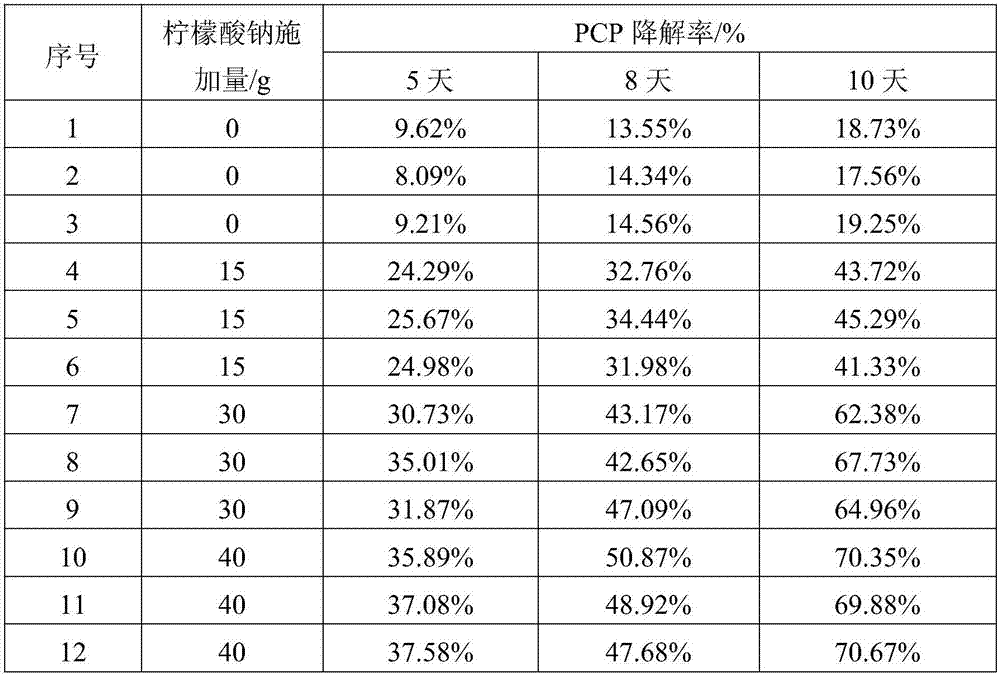Method of accelerating in-situ degradation of PCP in paddy field
A paddy field, in-situ technology, applied in the field of remediation of polluted soil, can solve the problems of long degradation cycle, secondary pollution and high cost, and achieve the effects of fast degradation rate, easy operation and low cost of raw materials
- Summary
- Abstract
- Description
- Claims
- Application Information
AI Technical Summary
Problems solved by technology
Method used
Image
Examples
Embodiment example 1
[0013] Implementation Case 1: The promotion test of sodium citrate on the degradation of PCP in the soil solution system.
[0014] Paddy soil contaminated by PCP was collected from Guangdong Province, air-dried and sieved. 0.5g (dry weight) of soil, 10ml of PIPES buffer solution, and PCP with a final concentration of 5mg / L were added to a 20ml sterilized vial. Add 5mmol / L, 10mmol / L, 12mmol / L, 15mmol / L of sodium citrate respectively, culture in anaerobic and dark-proof biochemical incubator at 30°C, and take regular samples for analysis. Mainly detect PCP concentration, metabolite concentration, Fe(II) concentration and extract DNA to analyze the composition of microbial community, use ultrasonic vibration to extract residual PCP in the solution, high performance liquid chromatography to detect the residual concentration of PCP, and GC-MS to detect the metabolites of PCP , UV-Vis spectrophotometer to detect Fe (Ⅱ) concentration, and extract DNA application pyrosequencing. The...
Embodiment example 2
[0017] Implementation case 2: PCP in situ degradation test in paddy field.
[0018] In this case, the on-site repair test was adopted. The experimental site is a paddy field polluted by PCP in Dongpu Town, Zhongshan City, Guangdong Province, and the concentration of PCP is about 40ng / g (dry weight). First, the paddy field was plowed and leveled to keep it flooded, and then it was divided into 12 square paddy field grids of 2m×2m in total, with a 100cm gap between each grid. The mass of sodium citrate applied in each grid was 0g, 15g, 30g and 40g respectively; each application amount was repeated three times, except that the application amount of sodium citrate was different, all other conditions were the same. Then rice was planted according to the normal rice planting procedure, fertilization, weeding, keeping the flooded state, and keeping the water level of all treatments consistent, and continuously measuring the concentration change of PCP. The results are shown in Tabl...
PUM
 Login to View More
Login to View More Abstract
Description
Claims
Application Information
 Login to View More
Login to View More - R&D
- Intellectual Property
- Life Sciences
- Materials
- Tech Scout
- Unparalleled Data Quality
- Higher Quality Content
- 60% Fewer Hallucinations
Browse by: Latest US Patents, China's latest patents, Technical Efficacy Thesaurus, Application Domain, Technology Topic, Popular Technical Reports.
© 2025 PatSnap. All rights reserved.Legal|Privacy policy|Modern Slavery Act Transparency Statement|Sitemap|About US| Contact US: help@patsnap.com


